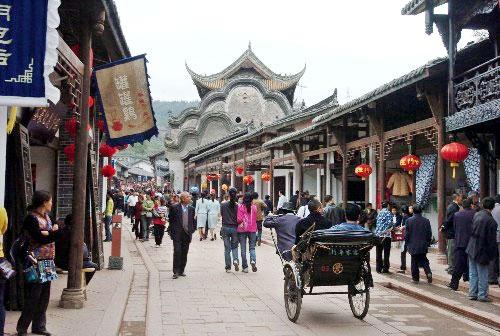Luodai Ancient Town
Established in the Han Dynasty (206 B.C.-220), Luodai is an ancient town situated in an eastern suburb of Chengdu (the city of 72-hour China visa free), some 20 kilometers (12.43 miles) from the city's downtown area. There are around 23,000 inhabitants now living in the town, of whom about 20,000 are Hakka people. Therefore, it is known as the largest gathering place for Hakka people in China's southwestern region.
Most of the Hakka people in the Luodai Ancient Town are migrants who were forced into Sichuan Province from Guangdong, Jiangxi and Hubei provinces by Manchurian rulers during the early Qing Dynasty (1644-1911).
The whole township has been well-preserved, with over 1,000-year-old ancient streets and Ming- and Qing-style residences, buildings and stores. There are one 1,000-meter-long main street and seven alleys in the ancient town where visitors can take a walk and look around. The Guangdong Guildhall is the town's landmark; the museum and the park are also worth visiting.
Admission: Free
Du Fu Thatched Cottage
The Du Fu Thatched Cottage is an idyllic park and museum situated in the western suburbs of Chengdu, Sichuan Province, adjacent to the picturesque Flower Rinsing Brook. And it is must-see in Chengdu for China vacation deals. The museum, in honor of famous Tang poet Du Fu (712-770), is considered a sacred spot of Chinese literature. Du Fu, one of the greatest Chinese poets, set up a straw-roofed house by the brook in 759, and lived there for about four years. In his thatched hut, he was inspired to compose more than 240 poems, including his best known ones such as "Thatched Hut Torn Apart by Autumn Wind" and "The Prime Minister of Shu."
The original hut built by Du was destroyed and the major buildings we see today were constructed during the Ming Dynasty in 1500, and renovated in 1811 during the Qing Dynasty. They include the Thatched Cottage, Former Residence of Du Fu, Screen Wall, Front Gate, Grand Lobby, Memorial of the Poet-Historian, Firewood Gate and Gongbu Shrine. The museum is noted for its unsophisticated historical relics, elegant buildings and tranquil environment. It's a tourist attraction for visitors from around the world to pay tribute to the poet Du Fu.
Admission: 60 yuan (US$9.8) / person
Wuhou Temple
The Wuhou Temple, also known as the Martial Marquis Memorial Temple, is located in Chendu's Wuhou District. It was built in 223 in commemoration of Zhuge Liang, prime minister of the Shu State during the Three Kingdoms (220–280). In the beginning of the Ming Dynasty (1368-1644, learn more via China guide), it was merged with the Zhaolie Temple in commemoration of Liu Bei, the founding emperor of the Kingdom of Shu.
There are numerous historical relics such as the horizontal cribbed boards, couplets, inscribed tablets, penmanship, furnaces, Chinese tripods, etc. The Sanjue (Three-Best) horizontal inscribed board, Chu Shi Biao and the hall of Liu Bei are the most famous ones.
It is the only temple in China which sacrifices to both an emperor and a minister, as well as the largest museum displaying the relics of the Three Kingdoms.
Admission: 60 yuan (US$9.8) / person
Tiantai Mountain
Located in Qionglai, the Tiantai Mountain is about 120 kilometers (74.56 miles) away from Chengdu. The scenic spot boasts the syncline hilly landform, a one of a kind in China. Measuring 1,812 meters in height, its main peak forms the perfect place to watch the sunrise and the sea of clouds. The seven waterfalls are the most famous attractions of the area, especially the Xiangshuitan Waterfall which makes a sheer drop of 40 meters. The Tiantai Mountain is a paradise for over 80 species of flowers, 360 types of trees and more than 50 of wild animal species.
Admission: 65 yuan (US$10.6) / person
?Wangjiang Tower Park
The Wangjiang Tower Park is located at the southern bank of Jinjiang River, Chengdu. It was built in the Ming (1368-1644) and Qing (1644-1911) dynasties in commemoration of Xue Tao, the first woman poet of Tang Dynasty (618-907). Covering an area of 176.5 mu (11.77 hectares), the park features waters, pavilions, bridges and towers. It is especially known for its surrounding unique bamboo forest.
The Chongli Tower, or Wangjiang Tower, is the landmark of the park. Wangjiang Tower literally means "a tower that overlooks the river." Built in 1889, the octagonal tower with four stories measures 39 meters in height and is made solely out of wood.
Other unique ancient architectural buildings in the park, including Yinshilou (Poem Chanting Tower), Wuyunxianguan (Five Fairy Clouds Hall), Quanxiangxie (Fragrance of Stream Pavilion), are also worth a visit for your best tours of China.
Admission: 20 yuan (US$3.27) / person

No comments:
Post a Comment